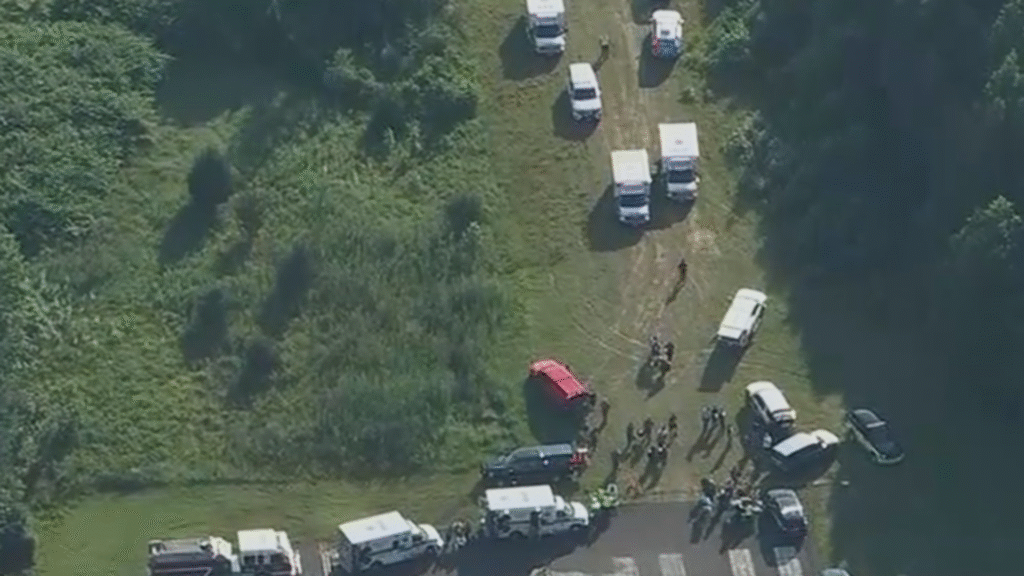
Federal investigators have released their initial findings on a dramatic skydiving plane crash in Gloucester County, New Jersey, earlier this month that left 15 people injured.
According to the National Transportation Safety Board (NTSB), the accident occurred on July 2, 2025, when a Cessna 208B, registration number N716MM, was operating from Cross Keys Airport in Monroe Township. The aircraft, owned by ARNE Aviation LLC of Virginia and leased by Skydive Cross Keys, was conducting routine skydiving operations at the time of the crash.
Records show the aircraft first departed at 4:23 p.m. for an 18-minute skydive run without incident. After returning, the plane was refueled with 44.9 gallons of Jet-A, bringing its total fuel load to about 800 pounds. It then departed again at 5:14 p.m. for another jump flight.
Shortly before 5:30 p.m., while climbing through approximately 3,000 feet above sea level, the pilot reported a sudden loss of engine power. Witnesses on the ground and data from the Federal Aviation Administration (FAA) confirm that the pilot began maneuvering to glide the plane back toward Runway 27 at Cross Keys Airport.
The NTSB’s preliminary report describes how the plane touched down near the far end of the runway, overshot it, and then traveled off the paved surface. The aircraft struck trees about 700 feet beyond the runway, damaging its wings and fuselage. The momentum carried it another 250 feet before it came to rest.
Investigators noted “substantial damage” to the plane, including severe structural harm to the fuselage and wings. Three of the aircraft’s four propeller blades had broken away from the hub, a sign of the intense impact forces.
There were two pilots and 13 passengers — all involved in the skydiving operation — on board at the time. Both pilots and 10 passengers sustained serious injuries, while the remaining three passengers suffered minor injuries. Emergency crews quickly transported the injured to nearby hospitals, and authorities say all victims are expected to survive.
NTSB records reveal that the same Cessna 208B had been involved in an earlier accident in 2023 in Virginia. That incident was unrelated to mechanical failure; investigators determined the likely cause at that time was the pilot’s inadequate landing flare, which resulted in damage to the aircraft.
The fact that the plane has now been involved in two crashes within a two-year span is likely to draw additional scrutiny as investigators examine its maintenance history, operational use, and any potential contributing factors from its past service.
The preliminary report does not provide a definitive cause for the July 2 engine failure. That determination will come later in the NTSB’s final report, which could take months. In the meantime, investigators will be analyzing the aircraft’s maintenance records, engine components, and fuel system. They will also interview the pilots, passengers, and any relevant witnesses to piece together the exact chain of events.
The FAA is assisting in the investigation, as is standard for incidents involving U.S.-registered aircraft. Both agencies stress that preliminary findings are subject to change as more evidence is reviewed.
The crash has sent shockwaves through the local skydiving community, where Cross Keys Airport has long been a hub for enthusiasts. Skydive Cross Keys temporarily suspended operations following the incident but has indicated it plans to resume once safety reviews are complete and federal authorities give clearance.
While skydiving is statistically a relatively safe sport when conducted by licensed operators, incidents involving aircraft — particularly those carrying large groups of jumpers — can have severe consequences. This crash is a reminder that while the jumps themselves are often the focus of safety concerns, the flights to altitude carry their own risks.
The NTSB’s final findings will aim to identify not only the direct cause of the accident but also any systemic safety issues that could be addressed to prevent similar events in the future.

